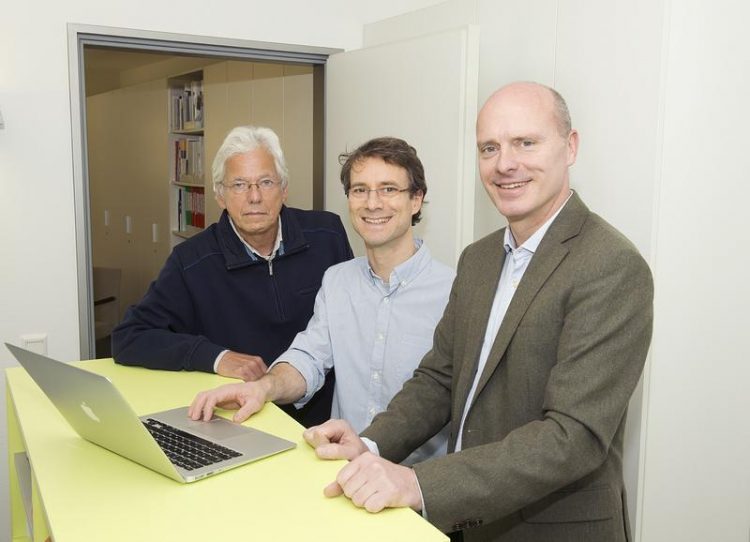Gene leads to malformation of the urinary tract

Prof. Dr. Michael Ludwig, Dr. Heiko Reutter and Prof. Dr. Markus Nöthen of the University of Bonn Hospital (from left). (c) Photo: Katharina Wislsperger/UKB
The kidneys and urinary tract are the sites affected most frequently by congenital malformations. Approximately 1 out of every 200 children suffers from such a malformation.
“These diseases make up about 20 to 30 percent of all congenital malformations,” says Associate Professor Dr. Heiko Reutter from the Institute of Human Genetics and the Department of Neonatology and Pediatric Intensive Care Medicine of the University of Bonn.
For many years, the pediatrician has investigated the genetic causes of classic bladder exstrophy comprising malformations ranging from the bladder to the entire urinary tract. These malformations frequently result in urinary tract infections, incontinence, renal damage and sexual dysfunction.
Approximately one out of 20,000 newborns is affected by this rare disease which is considered to be one of the most severe forms of malformations on this spectrum. “Congenital classic bladder exstrophy thus represents an enormous challenge in the medical care of patients affected and their families,” says Dr. Reutter.
Focus at the Center for Rare Diseases
To date, the genetic causes of this rare disease have been basically unknown. In the past ten years, with the bladder extrophy/epispadias self-help group and leading pediatric urologists and pediatric surgeons in Germany – including from the Barmherzigen Brüder Pediatric Hospital in Regensburg as well as the universities of Mainz and Ulm – researchers at the University of Bonn hospital have been able to gather the largest group of patients in the world.
The researchers in Bonn received additional support for the current study from researchers at the Max Planck Institute for Molecular Genetics in Berlin. Assistance was also provided by the Center for Rare Diseases at the University of Bonn Hospital (ZSEB). The researchers focus on rare uro-rectal malformations there.
Using blood samples from a total of 210 patients, the scientists isolated the genetic information and compared it with a control group of healthy persons. The researchers used automated analysis methods to record more than 700,000 genetic markers in each case which are evenly distributed throughout the DNA.
The evaluation using biostatistical methods revealed a clear connection with an altered gene: ISL1, which is located on chromosome five. “In this way, a gene in connection with this disease was identified for the very first time,” says Prof. Dr. Michael Ludwig from the Institute of Clinical Chemistry and Clinical Pharmacology of the University of Bonn Hospital.
The search for other genes
This has been a breakthrough for science. “With the discovery of this gene, it now becomes possible to clarify the biological foundations of this disease,” says Prof. Dr. Markus Nöthen from the Institute of Human Genetics from the University of Bonn. Beyond the genetic causes of classic exstrophy, the objective is to now identify risk factors during pregnancy and to develop preventive approaches from this for the unborn child.
Further investigations are intended to demonstrate which yet undiscovered genes play an additional role in the development of the disease. The scientists are still looking for affected to continue the studies. Anyone interested may email Dr. Reutter directly: reutter@uni-bonn.de.
Publication: Genome-wide association study and meta-analysis identify ISL1 as genome-wide significant susceptibility gene for bladder exstrophy, “PLOS Genetics”, DOI: 10.1371/journal.pgen.1005024.
Media contact information:
PD Dr. Heiko Reutter
Institute of Human Genetics/Department
of Neonatology and Pediatric Intensive Care Medicine
of the University of Bonn Hospital
Tel. ++49-(0)228-28751000
E-Mail: reutter@uni-bonn.de
Media Contact
More Information:
http://www.uni-bonn.de/All latest news from the category: Interdisciplinary Research
News and developments from the field of interdisciplinary research.
Among other topics, you can find stimulating reports and articles related to microsystems, emotions research, futures research and stratospheric research.
Newest articles

Properties of new materials for microchips
… can now be measured well. Reseachers of Delft University of Technology demonstrated measuring performance properties of ultrathin silicon membranes. Making ever smaller and more powerful chips requires new ultrathin…

Floating solar’s potential
… to support sustainable development by addressing climate, water, and energy goals holistically. A new study published this week in Nature Energy raises the potential for floating solar photovoltaics (FPV)…

Skyrmions move at record speeds
… a step towards the computing of the future. An international research team led by scientists from the CNRS1 has discovered that the magnetic nanobubbles2 known as skyrmions can be…





















